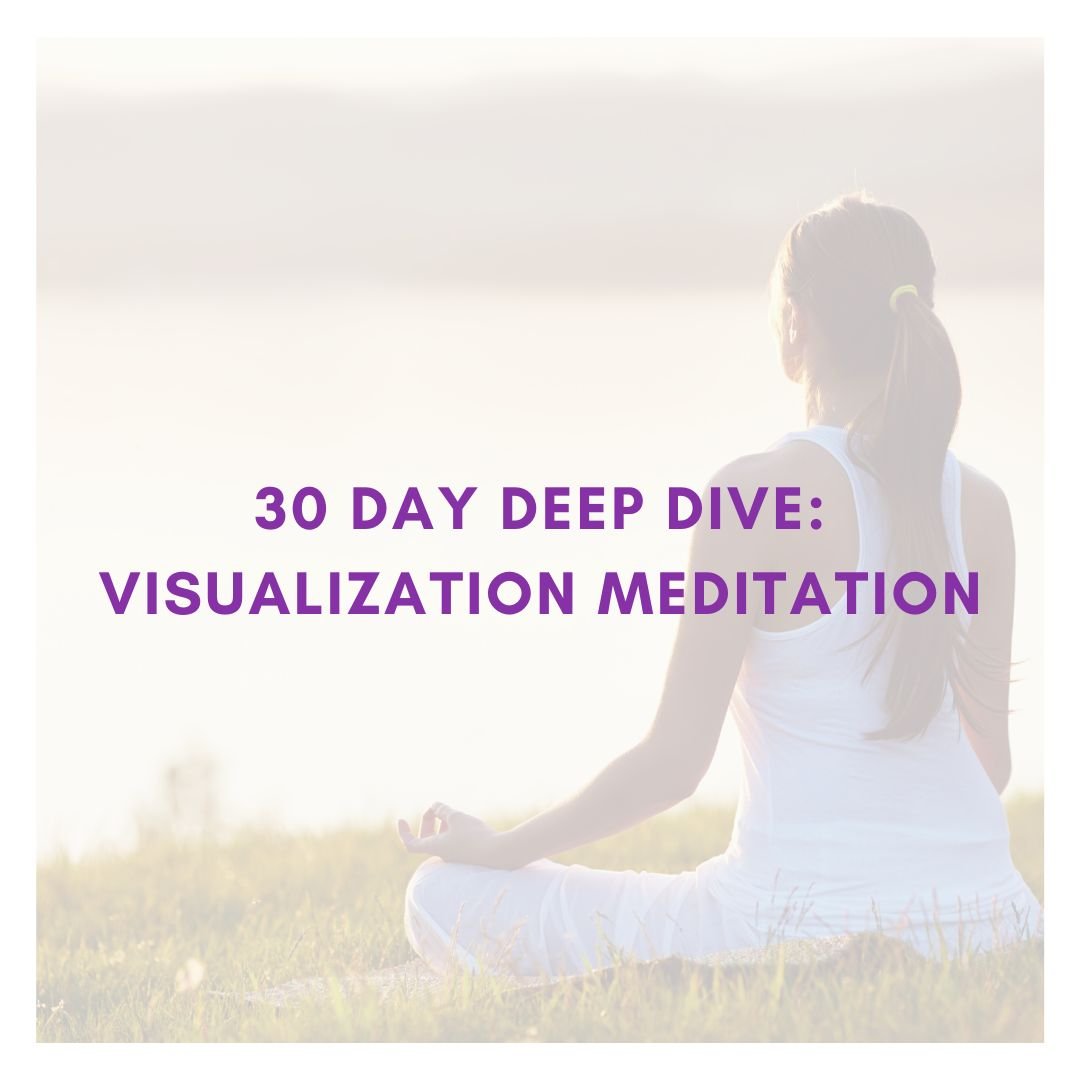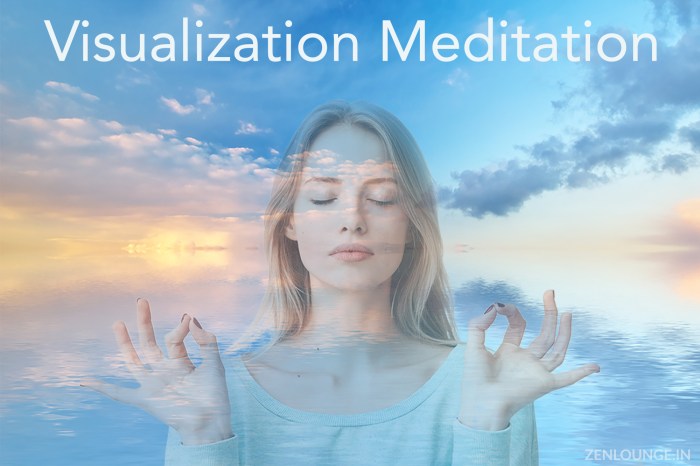4 Visualization Techniques for Meditation Success sets the stage for this enthralling narrative, offering readers a glimpse into a story that is rich in detail with academic with authoritative tone style and brimming with originality from the outset.
Visualization techniques play a crucial role in meditation practices, elevating the experience to new heights. By exploring different visualization methods and creating a personalized routine, individuals can deepen their meditation practice and achieve success.
Importance of Visualization in Meditation

Visualization techniques play a crucial role in enhancing meditation practices by helping individuals focus their minds and deepen their state of relaxation. Unlike traditional meditation, which relies solely on breath awareness or mantra repetition, visualization-enhanced meditation involves creating mental images to guide the mind towards a specific goal or intention.
Benefits of Visualization in Meditation
- Enhanced Focus: Visualization techniques help in directing and maintaining focus during meditation, reducing distractions and promoting a deeper state of concentration.
- Stress Reduction: By visualizing peaceful scenes or positive outcomes, individuals can reduce stress levels and promote a sense of calmness and inner peace.
- Emotional Healing: Visualization allows individuals to work through emotional blockages or trauma by visualizing a safe and healing environment, promoting emotional well-being.
- Goal Manifestation: Through visualization, individuals can manifest their goals and intentions by creating a clear mental image of their desired outcome, enhancing motivation and determination.
Types of Visualization Techniques: 4 Visualization Techniques For Meditation Success

Visualization techniques are powerful tools that can enhance the effectiveness of meditation practice. Here are four common visualization techniques that can help you achieve meditation success:
1. Guided Imagery
Guided imagery involves visualizing specific scenes or scenarios guided by a narrator or a recorded audio. To practice this technique effectively, find a quiet and comfortable place to sit or lie down. Close your eyes and listen to the guided imagery recording, allowing yourself to immerse in the detailed mental images presented. This technique can be most beneficial for reducing stress, enhancing relaxation, and promoting positive thinking.
2. Body Scan Visualization
Body scan visualization involves focusing on different parts of the body and visualizing them in a relaxed state. To practice this technique, start by lying down in a comfortable position. Close your eyes and bring your attention to your toes, visualizing them relaxing and releasing tension. Slowly move your focus up through each body part, visualizing relaxation and peace spreading throughout.
Body scan visualization can be beneficial for releasing physical tension, promoting body awareness, and improving overall relaxation.
3. Nature Visualization
Nature visualization involves imagining yourself in a peaceful natural setting, such as a serene forest, a tranquil beach, or a lush garden. To practice this technique, close your eyes and visualize the sights, sounds, and smells of the natural environment. Imagine yourself walking through the setting, taking in the beauty and tranquility around you. Nature visualization can be beneficial for reducing anxiety, increasing feelings of calmness, and connecting with the present moment.
4. Color Visualization, 4 Visualization Techniques for Meditation Success
Color visualization involves focusing on specific colors and their associated emotions or qualities. To practice this technique, choose a color that resonates with you at the moment. Close your eyes and visualize the color surrounding you, filling you with its energy and meaning. Focus on how the color makes you feel and how it affects your mood and mindset. Color visualization can be beneficial for shifting emotions, enhancing focus, and promoting emotional balance.
Creating a Visualization Meditation Routine

Creating a personalized visualization meditation routine can significantly enhance your meditation practice and overall well-being. By designing a routine tailored to your preferences and goals, you can optimize the benefits of visualization techniques and achieve meditation success more effectively.
Step-by-Step Guide
- Start by setting aside a specific time each day for your visualization meditation practice. Consistency is key to reaping the full benefits of this technique.
- Find a quiet and comfortable space where you can relax without distractions. This will help you focus better during your meditation sessions.
- Begin your routine with a few minutes of deep breathing exercises to calm your mind and body before diving into visualization techniques.
- Choose a visualization technique that resonates with you, whether it’s guided imagery, positive affirmations, mental rehearsal, or any other method that aligns with your goals.
- Visualize your desired outcomes with as much detail as possible, engaging all your senses to make the experience more vivid and compelling.
- Practice your chosen visualization technique for at least 10-15 minutes per session, gradually increasing the duration as you become more comfortable with the practice.
- End each session by expressing gratitude for the experience and setting positive intentions for the rest of your day.
Consistency is Key
Consistency in practice is crucial for achieving success in visualization meditation. By committing to a regular routine and sticking to it, you allow your mind to become more attuned to the practice, making it easier to enter a meditative state and manifest your intentions. Over time, consistent practice can lead to profound changes in your mindset, behavior, and overall well-being.
Tips for Mastering Visualization in Meditation

Visualization meditation can be a powerful tool for achieving inner peace and mental clarity. Here are some tips to help you master visualization techniques and enhance your meditation practice:
Staying Focused and Avoiding Distractions
- Avoid meditating in a noisy or cluttered environment, as external distractions can hinder your ability to focus.
- Set aside dedicated time for visualization meditation each day to build consistency and reinforce the habit.
- Practice mindfulness to help train your mind to stay present and focused during your visualization sessions.
- If you find your mind wandering, gently guide your focus back to your visualization without judgment.
Overcoming Common Challenges
- It is normal to experience difficulty in visualizing at first. Start with simple images or scenes and gradually work your way up to more complex visualizations.
- If you are struggling to maintain a clear mental image, try using guided meditation recordings or written scripts to help guide your visualization.
- Practice patience and be kind to yourself as you navigate the learning curve of visualization meditation. Progress may take time, but consistency is key.
Deepening the Connection to Inner Peace
- Focus on incorporating positive emotions and sensations into your visualizations to deepen the emotional impact and strengthen the connection to inner peace.
- Engage all your senses in your visualizations to create a more immersive and vivid experience, enhancing the connection between your mind and body.
- Acknowledge any resistance or discomfort that arises during visualization and use it as an opportunity for growth and self-awareness.
Final Wrap-Up

In conclusion, mastering visualization techniques in meditation requires dedication and practice. By incorporating these techniques into your routine and staying focused, you can enhance your inner peace and overall well-being. Embrace the power of visualization and unlock new levels of meditation success.